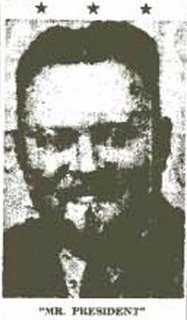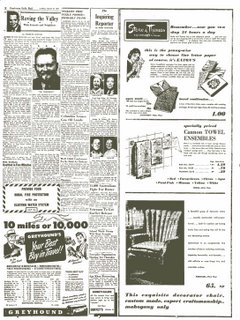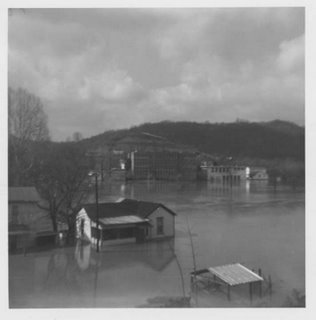
With our traditionally rough terrain and isolated location, transportation has been a huge factor in Orlando's history. The town came to be around 1900 because of a major change in the field of transportation: the railroad. When the railroad ceased stopping for passengers in the early 1940s there was a need for other arrangments.
 For many of the generally cash-poor residents, an auto was not considered a sound investment. Even with a car or truck, before I-79 and the general upgrading of the roads, if you had to go in to Weston you left right after breakfast and unless you planned to eat in town, you hurried to get back for a late dinner [served at we call lunchtime today]. That is, if you owned a car of truck.
For many of the generally cash-poor residents, an auto was not considered a sound investment. Even with a car or truck, before I-79 and the general upgrading of the roads, if you had to go in to Weston you left right after breakfast and unless you planned to eat in town, you hurried to get back for a late dinner [served at we call lunchtime today]. That is, if you owned a car of truck. by David Parmer
Dial back the clock and leaf back through the calendar to the 1940’s and 1950’s and you can still find an older home shopping network, serving the households of Orlando, Clover Fork, and all up and down Oil Creek and Posey Run. There was no need to go to the store because the store came to you.
Weston Laundry and Cleaners
 paper to plaster the earth. Sewing notions of all kinds, such as thread, needles and fabric, were available as was a full line of similarly-appearing brown shoes and clothing preferred by farmers. E. J. Cox, the co-owner of this store, was well-known in Orlando as principal of the Orlando School and the Posey Run School, and was the owner of a farm at the mouth of McCauley Run.
paper to plaster the earth. Sewing notions of all kinds, such as thread, needles and fabric, were available as was a full line of similarly-appearing brown shoes and clothing preferred by farmers. E. J. Cox, the co-owner of this store, was well-known in Orlando as principal of the Orlando School and the Posey Run School, and was the owner of a farm at the mouth of McCauley Run. The Blue Goose Bus Line
 again Paul Knight was your man.
again Paul Knight was your man. Catalog Sales
In a classified ad
 in the Braxton Democrat in the August 1st, 1929 issue, under “Male Help Wanted,” the McNess Company of Freeport, Illinois solicited a “reliable man to run the McNess business in
in the Braxton Democrat in the August 1st, 1929 issue, under “Male Help Wanted,” the McNess Company of Freeport, Illinois solicited a “reliable man to run the McNess business in Braxton County.” Suggesting earnings of $8 to $12 per day, the prospective McNess salesman did not require any “capital investment or experience.” A McNess man frequently made calls in Orlando, mostly during times of good weather, taking orders for all sorts of household goods such as baking pans and Corningware. The last two items were purchased by Helen Jeffries of Oil Creek from Mr. Curry, the McNess salesman in the 1960’s. The McNess line also included pie fillings, Jello puddings and spices.
Braxton County.” Suggesting earnings of $8 to $12 per day, the prospective McNess salesman did not require any “capital investment or experience.” A McNess man frequently made calls in Orlando, mostly during times of good weather, taking orders for all sorts of household goods such as baking pans and Corningware. The last two items were purchased by Helen Jeffries of Oil Creek from Mr. Curry, the McNess salesman in the 1960’s. The McNess line also included pie fillings, Jello puddings and spices. Drummers, Pack Peddlers and Salesmen
 Lis Thomas
Lis ThomasInto the early 20th century, pack peddlers scoured the hills and hollows, bringing all sorts of novelties to Orlando housewives, ranging from underclothes to razor blades, dresses and perfumes. Lis Thomas, a Syrian peddler, was perhaps the last such pack peddler who served Orlando customers during the early 1950’s.
“Would You Like to Own a Victrola?”
Dale Barnett recalls during the pre-Depression days in Orlando that a door to door salesman sold a victrola to his parents, Bill and Marie Barnett. Dale believes that the salesman stayed at the Dolan Hotel while he was visiting the families of Orlando and enticing them with the melodious sounds of Al Jolson. Since the victrolas were hand-cranked, there was no need of electricity to enjoy the music of the day.
 Charlie Alkire of Clover Fork also came into the taxi stand to get a cab home. Becoming aware that Jimmie was waiting on hot dogs, Charlie also placed a “to-go” order for two 15 cent hotdogs. Since this was the late 1950’s and Chinese food was unheard of, at least to this writer, the taxi stand hot dogs were the next best thing. Jimmie and Charlie probably anticipated the enjoyment of the famous taxi stand hot dogs as they shared a taxi ride up Oil Creek.
Charlie Alkire of Clover Fork also came into the taxi stand to get a cab home. Becoming aware that Jimmie was waiting on hot dogs, Charlie also placed a “to-go” order for two 15 cent hotdogs. Since this was the late 1950’s and Chinese food was unheard of, at least to this writer, the taxi stand hot dogs were the next best thing. Jimmie and Charlie probably anticipated the enjoyment of the famous taxi stand hot dogs as they shared a taxi ride up Oil Creek. We don't have photo of old Charlie Alkire, but to the left is Jimmie Doc Henline.
Right: As this ad suggests, Grit was a part of rural culture in the first half of the 20th century.
The Grit
 The Grit was a popular newspaper in Orlando in the 1940’s and 1950’s. The classified section of the newspaper offered all sorts of things for sale. Coon hunters could buy the best dog on the continent and fox chasers could buy the fastest runners of the wily fox. Farmers could buy chicks and those in need of fancy shoes could buy patent leather.
The Grit was a popular newspaper in Orlando in the 1940’s and 1950’s. The classified section of the newspaper offered all sorts of things for sale. Coon hunters could buy the best dog on the continent and fox chasers could buy the fastest runners of the wily fox. Farmers could buy chicks and those in need of fancy shoes could buy patent leather. are Long Gone

























